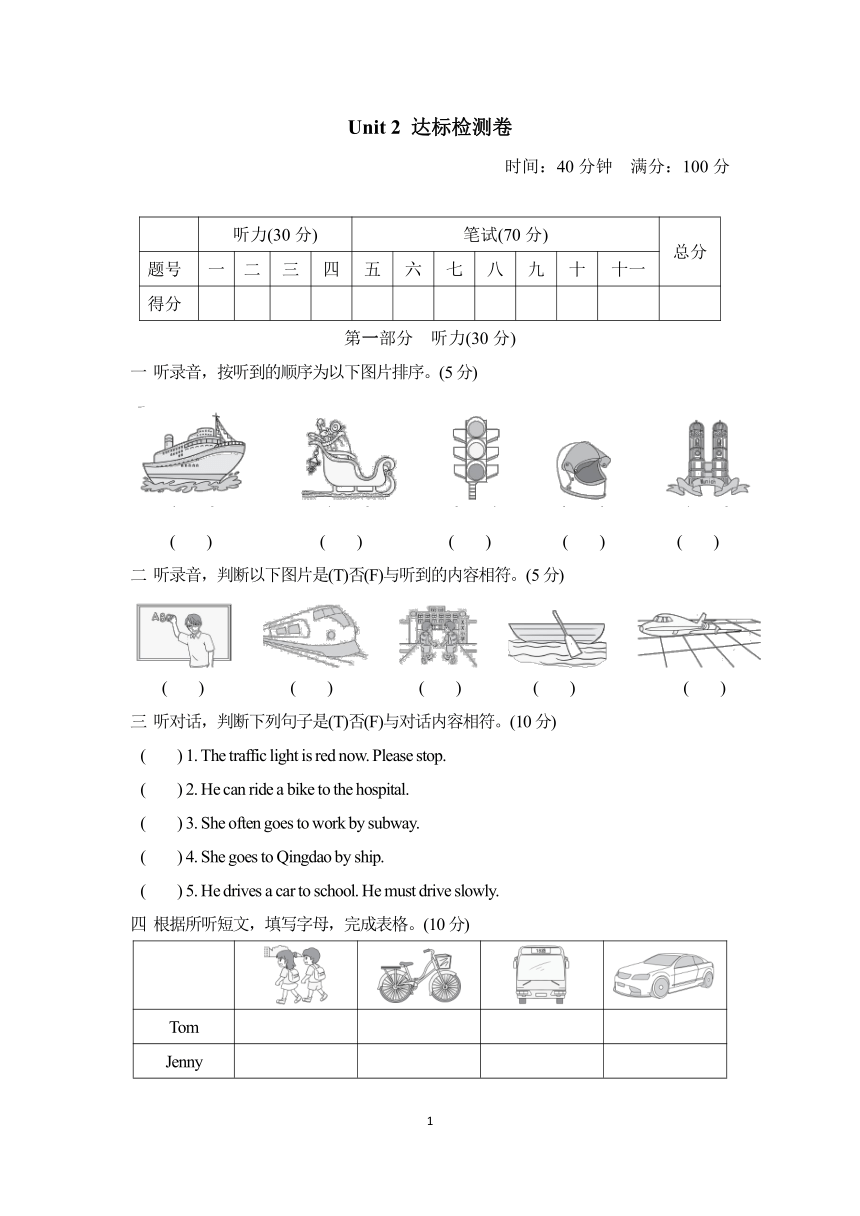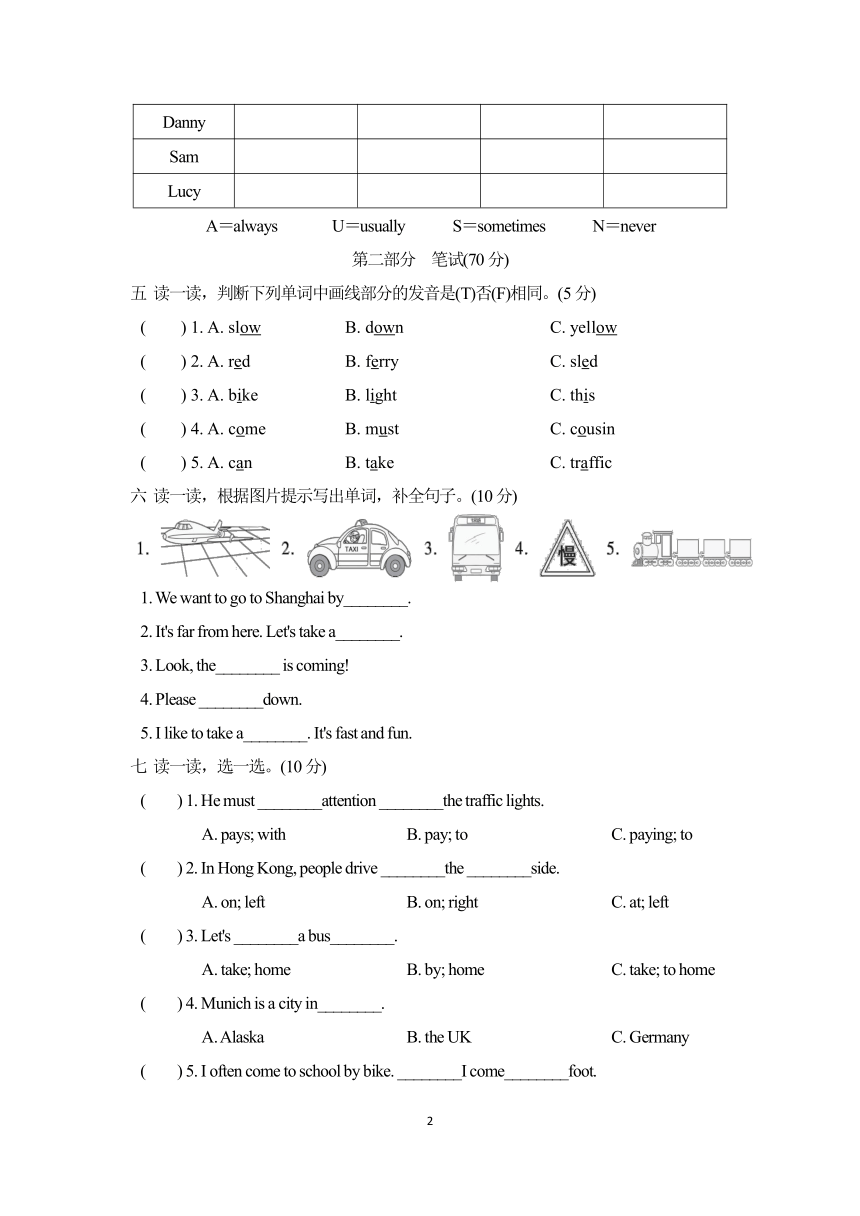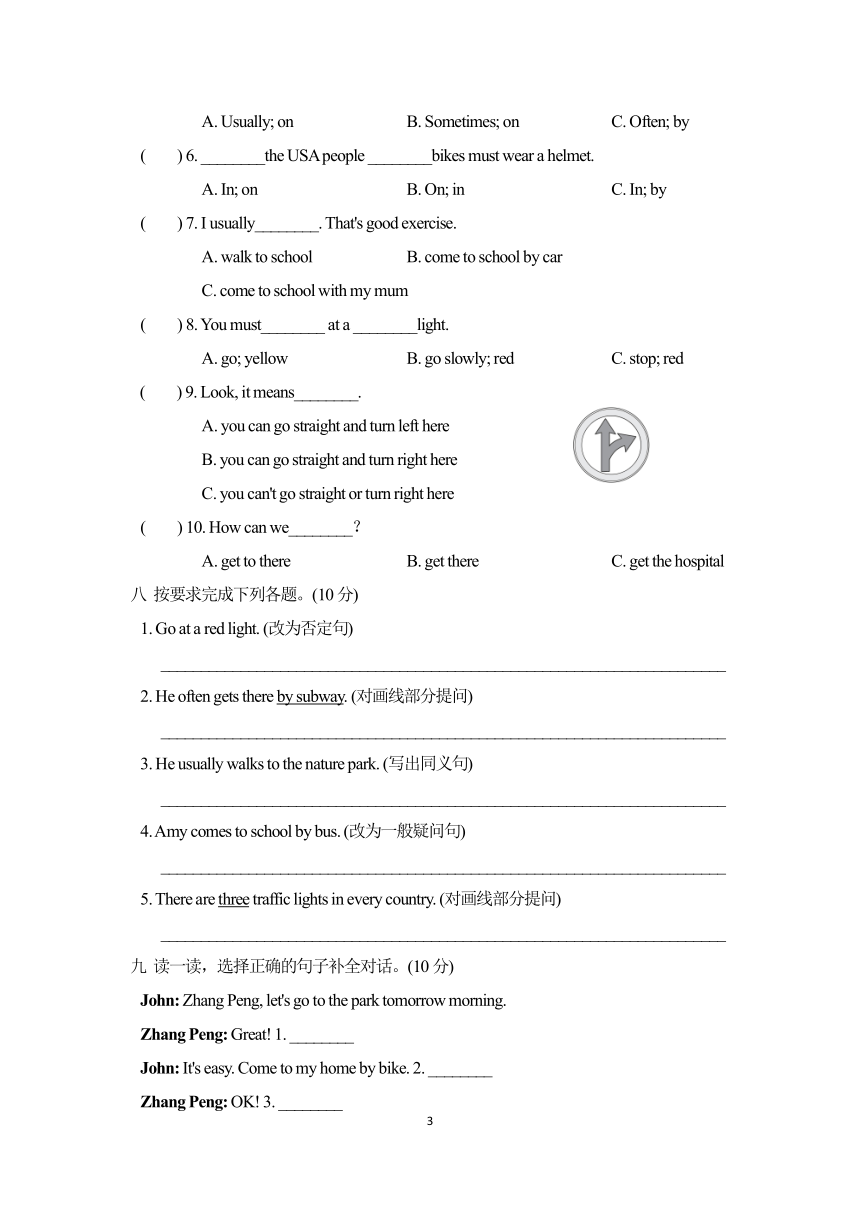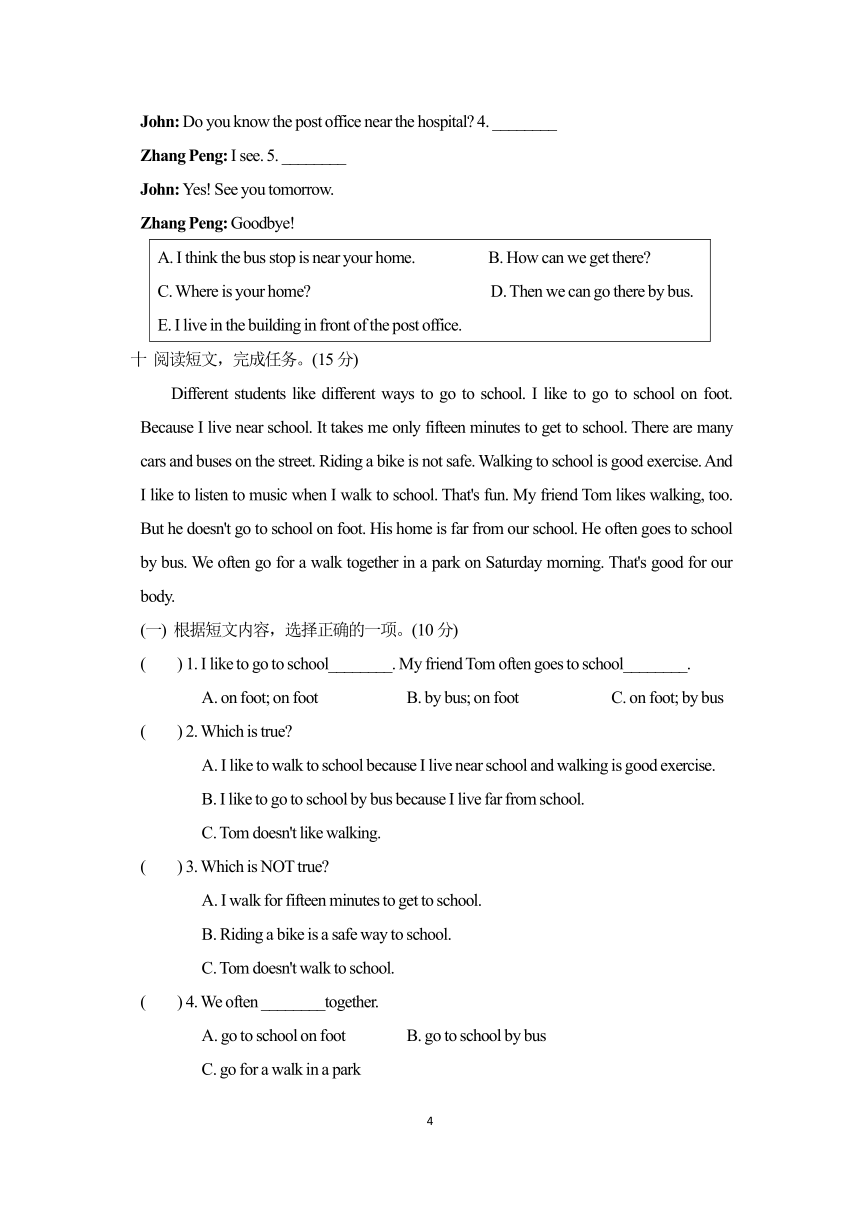Unit 2 Ways to go to school 达标测试卷(含答案及听力书面材料 无音频)
文档属性
| 名称 | Unit 2 Ways to go to school 达标测试卷(含答案及听力书面材料 无音频) |  | |
| 格式 | zip | ||
| 文件大小 | 976.9KB | ||
| 资源类型 | 教案 | ||
| 版本资源 | 人教版(PEP) | ||
| 科目 | 英语 | ||
| 更新时间 | 2020-05-27 18:34:11 | ||
图片预览




文档简介
Unit
2
达标检测卷
时间:40分钟 满分:100分
听力(30分)
笔试(70分)
总分
题号
一
二
三
四
五
六
七
八
九
十
十一
得分
第一部分 听力(30分)
一
听录音,按听到的顺序为以下图片排序。(5分)
( )
( )
( )
( )
( )
二
听录音,判断以下图片是(T)否(F)与听到的内容相符。(5分)
( )
( )
( )
( )
( )
三
听对话,判断下列句子是(T)否(F)与对话内容相符。(10分)
( )
1.
The
traffic
light
is
red
now.
Please
stop.
( )
2.
He
can
ride
a
bike
to
the
hospital.
( )
3.
She
often
goes
to
work
by
subway.
( )
4.
She
goes
to
Qingdao
by
ship.
( )
5.
He
drives
a
car
to
school.
He
must
drive
slowly.
四
根据所听短文,填写字母,完成表格。(10分)
Tom
Jenny
Danny
Sam
Lucy
A=always
U=usually S=sometimes N=never
第二部分 笔试(70分)
五
读一读,判断下列单词中画线部分的发音是(T)否(F)相同。(5分)
( )
1.
A.
slow
B.
down
C.
yellow
( )
2.
A.
red
B.
ferry
C.
sled
( )
3.
A.
bike
B.
light
C.
this
( )
4.
A.
come
B.
must
C.
cousin
( )
5.
A.
can
B.
take
C.
traffic
六
读一读,根据图片提示写出单词,补全句子。(10分)
1.
We
want
to
go
to
Shanghai
by________.
2.
It's
far
from
here.
Let's
take
a________.
3.
Look,
the________
is
coming!
4.
Please
________down.
5.
I
like
to
take
a________.
It's
fast
and
fun.
七
读一读,选一选。(10分)
( )
1.
He
must
________attention
________the
traffic
lights.
A.
pays;
with
B.
pay;
to
C.
paying;
to
( )
2.
In
Hong
Kong,
people
drive
________the
________side.
A.
on;
left
B.
on;
right
C.
at;
left
( )
3.
Let's
________a
bus________.
A.
take;
home
B.
by;
home
C.
take;
to
home
( )
4.
Munich
is
a
city
in________.
A.
Alaska
B.
the
UK
C.
Germany
( )
5.
I
often
come
to
school
by
bike.
________I
come________foot.
A.
Usually;
on
B.
Sometimes;
on
C.
Often;
by
( )
6.
________the
USA
people
________bikes
must
wear
a
helmet.
A.
In;
on
B.
On;
in
C.
In;
by
( )
7.
I
usually________.
That's
good
exercise.
A.
walk
to
school
B.
come
to
school
by
car
C.
come
to
school
with
my
mum
( )
8.
You
must________
at
a
________light.
A.
go;
yellow
B.
go
slowly;
red
C.
stop;
red
( )
9.
Look,
it
means________.
A.
you
can
go
straight
and
turn
left
here
B.
you
can
go
straight
and
turn
right
here
C.
you
can't
go
straight
or
turn
right
here
( )
10.
How
can
we________?
A.
get
to
there
B.
get
there
C.
get
the
hospital
八
按要求完成下列各题。(10分)
1.
Go
at
a
red
light.
(改为否定句)
_______________________________________________________________________
2.
He
often
gets
there
by
subway.
(对画线部分提问)
_______________________________________________________________________
3.
He
usually
walks
to
the
nature
park.
(写出同义句)
_______________________________________________________________________
4.
Amy
comes
to
school
by
bus.
(改为一般疑问句)
_______________________________________________________________________
5.
There
are
three
traffic
lights
in
every
country.
(对画线部分提问)
_______________________________________________________________________
九
读一读,选择正确的句子补全对话。(10分)
John:
Zhang
Peng,
let's
go
to
the
park
tomorrow
morning.
Zhang
Peng:
Great!
1.
________
John:
It's
easy.
Come
to
my
home
by
bike.
2.
________
Zhang
Peng:
OK!
3.
________
John:
Do
you
know
the
post
office
near
the
hospital?
4.
________
Zhang
Peng:
I
see.
5.
________
John:
Yes!
See
you
tomorrow.
Zhang
Peng:
Goodbye!
A.
I
think
the
bus
stop
is
near
your
home.
B.
How
can
we
get
there?C.
Where
is
your
home?
D.
Then
we
can
go
there
by
bus.
E.
I
live
in
the
building
in
front
of
the
post
office.
十
阅读短文,完成任务。(15分)
Different
students
like
different
ways
to
go
to
school.
I
like
to
go
to
school
on
foot.
Because
I
live
near
school.
It
takes
me
only
fifteen
minutes
to
get
to
school.
There
are
many
cars
and
buses
on
the
street.
Riding
a
bike
is
not
safe.
Walking
to
school
is
good
exercise.
And
I
like
to
listen
to
music
when
I
walk
to
school.
That's
fun.
My
friend
Tom
likes
walking,
too.
But
he
doesn't
go
to
school
on
foot.
His
home
is
far
from
our
school.
He
often
goes
to
school
by
bus.
We
often
go
for
a
walk
together
in
a
park
on
Saturday
morning.
That's
good
for
our
body.
(一)
根据短文内容,选择正确的一项。(10分)
( )
1.
I
like
to
go
to
school________.
My
friend
Tom
often
goes
to
school________.
A.
on
foot;
on
foot
B.
by
bus;
on
foot
C.
on
foot;
by
bus
( )
2.
Which
is
true?
A.
I
like
to
walk
to
school
because
I
live
near
school
and
walking
is
good
exercise.
B.
I
like
to
go
to
school
by
bus
because
I
live
far
from
school.
C.
Tom
doesn't
like
walking.
( )
3.
Which
is
NOT
true?
A.
I
walk
for
fifteen
minutes
to
get
to
school.
B.
Riding
a
bike
is
a
safe
way
to
school.
C.
Tom
doesn't
walk
to
school.
( )
4.
We
often
________together.
A.
go
to
school
on
foot
B.
go
to
school
by
bus
C.
go
for
a
walk
in
a
park
( )
5.
Tom________.
A.
likes
walking
but
can't
walk
to
school
B.
doesn't
like
walking
but
walks
to
school
C.
likes
walking
and
walks
to
school
(二)
根据短文内容判断正(T)误(F)。(5分)
( )
1.
Different
students
like
different
ways
to
school.
( )
2.
I
like
listening
to
music
when
I
walk
to
school.
( )
3.
There
are
so
many
cars
and
buses
on
the
street.
I
often
take
a
bus
to
school.
( )
4.
Tom
and
I
think
walking
is
good
for
our
body.
( )
5.
Tom
and
I
walk
together
on
Sunday
morning.
十一
书面表达。(10分)
你通常采用什么方式去上学,你的家人采用什么方式去上班呢?你最喜欢哪种方式呢?为什么?请介绍一下吧。注意:不要出现自己的真实姓名,不得少于5句话。
________________________________________________________________________
________________________________________________________________________
________________________________________________________________________
参考答案
第一卷 听力部分
听力材料:
一、1.
It's
snowy.
We
go
by
sled.
2.
Please
wear
a
helmet.
3.
He
goes
to
work
by
ferry
every
day.
4.
It
is
in
Germany.
5.
Pay
attention
to
the
traffic
lights.
二、1.
Mrs
Green
is
our
English
teacher.
2.
My
father
goes
to
Hubei
by
train.
3.
We
usually
go
to
school
on
foot.
4.
You
can
go
there
by
train.
5.
Let's
take
a
plane.
It's
fast.
三、1.
Man:
Stop,
please.
Pay
attention
to
the
traffic
lights.
Woman:
Oh,
it's
red
now.
Thank
you.
2.
Man:
Excuse
me,
how
can
I
get
to
Renmin
Hospital?
Woman:
You
can
take
the
No.
32
bus
over
there.
3.
Man:
How
do
you
go
to
work?
Woman:
I
often
go
by
subway.
4.
Man:
How
do
you
get
to
Qingdao
from
Tianjin?
Woman:
I
go
there
by
ship.
5.
Man:
I
sometimes
go
to
school
by
sled.
Woman:
Oh,
that's
cool.
But
you
must
drive
slowly.
四、
Hello,
I'm
Tom.
I'm
a
boy.
I
live
near
my
school.
I
usually
go
to
school
on
foot.
Sometimes
I
go
by
bike.
My
friend
Jenny
lives
far
from
school.
She
usually
goes
to
school
by
car.
Sometimes
she
goes
by
bus.
Danny
always
goes
to
school
by
bus.
He
never
goes
on
foot.
Sam
usually
goes
by
bike.
Sometimes
he
goes
by
bus.
Lucy
always
walks
to
school.
She
never
goes
by
bike.
答案:
一、3 1 5 2 4
二、1.
F 2.
T 3.
T 4.
F 5.
T
三、1.
T
2.
F
3.
T 4.
T 5.
F
四、Tom:
U;S;/;/ Jenny:
/;/;S;U
Danny:
N;/;A;/ Sam:
/;
U;
S;/
Lucy:
A;N;/;/
五、1.
F 2.
T 3.
F 4.
T 5.
F
六、1.
plane 2.
taxi 3.
bus 4.
slow 5.
train
七、1.
B
2.
A 点拨:on.
.
.
side为固定搭配,香港与英国的交通规则是一样的,车辆需靠左行驶。
3.
A 点拨:let's后跟动词原形,by为介词,不符合要求。home为副词,前面不需要使用介词to。
4.
C 5.
B
6.
A 点拨:在某个国家应用介词in,people
on
bikes指骑在自行车上的人们。
7.
A 8.
C 9.
B 10.
B
八、1.
Don't
go
at
a
red
light.
2.
How
does
he
often
get
there?
3.
He
usually
goes
to
the
nature
park
on
foot.
4.
Does
Amy
come
to
school
by
bus?
5.
How
many
traffic
lights
are
there
in
every
country?
九、1.
B 2.
D 3.
C 4.
E 5.
A
十、(一)1.
C 2.
A 3.
B 4.
C 5.
A
(二)1.
T 2.
T 3.
F 4.
T 5.
F
十一、范文
I
live
near
school.
I
often
go
to
school
on
foot.
I
like
walking
with
my
friends
together.
My
mother
goes
to
work
by
bike.
My
father
often
goes
to
work
by
car.
I
like
walking
and
riding
a
bike.
I
think
they
are
good
for
our
body.
And
they
are
good
for
our
city.
2
达标检测卷
时间:40分钟 满分:100分
听力(30分)
笔试(70分)
总分
题号
一
二
三
四
五
六
七
八
九
十
十一
得分
第一部分 听力(30分)
一
听录音,按听到的顺序为以下图片排序。(5分)
( )
( )
( )
( )
( )
二
听录音,判断以下图片是(T)否(F)与听到的内容相符。(5分)
( )
( )
( )
( )
( )
三
听对话,判断下列句子是(T)否(F)与对话内容相符。(10分)
( )
1.
The
traffic
light
is
red
now.
Please
stop.
( )
2.
He
can
ride
a
bike
to
the
hospital.
( )
3.
She
often
goes
to
work
by
subway.
( )
4.
She
goes
to
Qingdao
by
ship.
( )
5.
He
drives
a
car
to
school.
He
must
drive
slowly.
四
根据所听短文,填写字母,完成表格。(10分)
Tom
Jenny
Danny
Sam
Lucy
A=always
U=usually S=sometimes N=never
第二部分 笔试(70分)
五
读一读,判断下列单词中画线部分的发音是(T)否(F)相同。(5分)
( )
1.
A.
slow
B.
down
C.
yellow
( )
2.
A.
red
B.
ferry
C.
sled
( )
3.
A.
bike
B.
light
C.
this
( )
4.
A.
come
B.
must
C.
cousin
( )
5.
A.
can
B.
take
C.
traffic
六
读一读,根据图片提示写出单词,补全句子。(10分)
1.
We
want
to
go
to
Shanghai
by________.
2.
It's
far
from
here.
Let's
take
a________.
3.
Look,
the________
is
coming!
4.
Please
________down.
5.
I
like
to
take
a________.
It's
fast
and
fun.
七
读一读,选一选。(10分)
( )
1.
He
must
________attention
________the
traffic
lights.
A.
pays;
with
B.
pay;
to
C.
paying;
to
( )
2.
In
Hong
Kong,
people
drive
________the
________side.
A.
on;
left
B.
on;
right
C.
at;
left
( )
3.
Let's
________a
bus________.
A.
take;
home
B.
by;
home
C.
take;
to
home
( )
4.
Munich
is
a
city
in________.
A.
Alaska
B.
the
UK
C.
Germany
( )
5.
I
often
come
to
school
by
bike.
________I
come________foot.
A.
Usually;
on
B.
Sometimes;
on
C.
Often;
by
( )
6.
________the
USA
people
________bikes
must
wear
a
helmet.
A.
In;
on
B.
On;
in
C.
In;
by
( )
7.
I
usually________.
That's
good
exercise.
A.
walk
to
school
B.
come
to
school
by
car
C.
come
to
school
with
my
mum
( )
8.
You
must________
at
a
________light.
A.
go;
yellow
B.
go
slowly;
red
C.
stop;
red
( )
9.
Look,
it
means________.
A.
you
can
go
straight
and
turn
left
here
B.
you
can
go
straight
and
turn
right
here
C.
you
can't
go
straight
or
turn
right
here
( )
10.
How
can
we________?
A.
get
to
there
B.
get
there
C.
get
the
hospital
八
按要求完成下列各题。(10分)
1.
Go
at
a
red
light.
(改为否定句)
_______________________________________________________________________
2.
He
often
gets
there
by
subway.
(对画线部分提问)
_______________________________________________________________________
3.
He
usually
walks
to
the
nature
park.
(写出同义句)
_______________________________________________________________________
4.
Amy
comes
to
school
by
bus.
(改为一般疑问句)
_______________________________________________________________________
5.
There
are
three
traffic
lights
in
every
country.
(对画线部分提问)
_______________________________________________________________________
九
读一读,选择正确的句子补全对话。(10分)
John:
Zhang
Peng,
let's
go
to
the
park
tomorrow
morning.
Zhang
Peng:
Great!
1.
________
John:
It's
easy.
Come
to
my
home
by
bike.
2.
________
Zhang
Peng:
OK!
3.
________
John:
Do
you
know
the
post
office
near
the
hospital?
4.
________
Zhang
Peng:
I
see.
5.
________
John:
Yes!
See
you
tomorrow.
Zhang
Peng:
Goodbye!
A.
I
think
the
bus
stop
is
near
your
home.
B.
How
can
we
get
there?C.
Where
is
your
home?
D.
Then
we
can
go
there
by
bus.
E.
I
live
in
the
building
in
front
of
the
post
office.
十
阅读短文,完成任务。(15分)
Different
students
like
different
ways
to
go
to
school.
I
like
to
go
to
school
on
foot.
Because
I
live
near
school.
It
takes
me
only
fifteen
minutes
to
get
to
school.
There
are
many
cars
and
buses
on
the
street.
Riding
a
bike
is
not
safe.
Walking
to
school
is
good
exercise.
And
I
like
to
listen
to
music
when
I
walk
to
school.
That's
fun.
My
friend
Tom
likes
walking,
too.
But
he
doesn't
go
to
school
on
foot.
His
home
is
far
from
our
school.
He
often
goes
to
school
by
bus.
We
often
go
for
a
walk
together
in
a
park
on
Saturday
morning.
That's
good
for
our
body.
(一)
根据短文内容,选择正确的一项。(10分)
( )
1.
I
like
to
go
to
school________.
My
friend
Tom
often
goes
to
school________.
A.
on
foot;
on
foot
B.
by
bus;
on
foot
C.
on
foot;
by
bus
( )
2.
Which
is
true?
A.
I
like
to
walk
to
school
because
I
live
near
school
and
walking
is
good
exercise.
B.
I
like
to
go
to
school
by
bus
because
I
live
far
from
school.
C.
Tom
doesn't
like
walking.
( )
3.
Which
is
NOT
true?
A.
I
walk
for
fifteen
minutes
to
get
to
school.
B.
Riding
a
bike
is
a
safe
way
to
school.
C.
Tom
doesn't
walk
to
school.
( )
4.
We
often
________together.
A.
go
to
school
on
foot
B.
go
to
school
by
bus
C.
go
for
a
walk
in
a
park
( )
5.
Tom________.
A.
likes
walking
but
can't
walk
to
school
B.
doesn't
like
walking
but
walks
to
school
C.
likes
walking
and
walks
to
school
(二)
根据短文内容判断正(T)误(F)。(5分)
( )
1.
Different
students
like
different
ways
to
school.
( )
2.
I
like
listening
to
music
when
I
walk
to
school.
( )
3.
There
are
so
many
cars
and
buses
on
the
street.
I
often
take
a
bus
to
school.
( )
4.
Tom
and
I
think
walking
is
good
for
our
body.
( )
5.
Tom
and
I
walk
together
on
Sunday
morning.
十一
书面表达。(10分)
你通常采用什么方式去上学,你的家人采用什么方式去上班呢?你最喜欢哪种方式呢?为什么?请介绍一下吧。注意:不要出现自己的真实姓名,不得少于5句话。
________________________________________________________________________
________________________________________________________________________
________________________________________________________________________
参考答案
第一卷 听力部分
听力材料:
一、1.
It's
snowy.
We
go
by
sled.
2.
Please
wear
a
helmet.
3.
He
goes
to
work
by
ferry
every
day.
4.
It
is
in
Germany.
5.
Pay
attention
to
the
traffic
lights.
二、1.
Mrs
Green
is
our
English
teacher.
2.
My
father
goes
to
Hubei
by
train.
3.
We
usually
go
to
school
on
foot.
4.
You
can
go
there
by
train.
5.
Let's
take
a
plane.
It's
fast.
三、1.
Man:
Stop,
please.
Pay
attention
to
the
traffic
lights.
Woman:
Oh,
it's
red
now.
Thank
you.
2.
Man:
Excuse
me,
how
can
I
get
to
Renmin
Hospital?
Woman:
You
can
take
the
No.
32
bus
over
there.
3.
Man:
How
do
you
go
to
work?
Woman:
I
often
go
by
subway.
4.
Man:
How
do
you
get
to
Qingdao
from
Tianjin?
Woman:
I
go
there
by
ship.
5.
Man:
I
sometimes
go
to
school
by
sled.
Woman:
Oh,
that's
cool.
But
you
must
drive
slowly.
四、
Hello,
I'm
Tom.
I'm
a
boy.
I
live
near
my
school.
I
usually
go
to
school
on
foot.
Sometimes
I
go
by
bike.
My
friend
Jenny
lives
far
from
school.
She
usually
goes
to
school
by
car.
Sometimes
she
goes
by
bus.
Danny
always
goes
to
school
by
bus.
He
never
goes
on
foot.
Sam
usually
goes
by
bike.
Sometimes
he
goes
by
bus.
Lucy
always
walks
to
school.
She
never
goes
by
bike.
答案:
一、3 1 5 2 4
二、1.
F 2.
T 3.
T 4.
F 5.
T
三、1.
T
2.
F
3.
T 4.
T 5.
F
四、Tom:
U;S;/;/ Jenny:
/;/;S;U
Danny:
N;/;A;/ Sam:
/;
U;
S;/
Lucy:
A;N;/;/
五、1.
F 2.
T 3.
F 4.
T 5.
F
六、1.
plane 2.
taxi 3.
bus 4.
slow 5.
train
七、1.
B
2.
A 点拨:on.
.
.
side为固定搭配,香港与英国的交通规则是一样的,车辆需靠左行驶。
3.
A 点拨:let's后跟动词原形,by为介词,不符合要求。home为副词,前面不需要使用介词to。
4.
C 5.
B
6.
A 点拨:在某个国家应用介词in,people
on
bikes指骑在自行车上的人们。
7.
A 8.
C 9.
B 10.
B
八、1.
Don't
go
at
a
red
light.
2.
How
does
he
often
get
there?
3.
He
usually
goes
to
the
nature
park
on
foot.
4.
Does
Amy
come
to
school
by
bus?
5.
How
many
traffic
lights
are
there
in
every
country?
九、1.
B 2.
D 3.
C 4.
E 5.
A
十、(一)1.
C 2.
A 3.
B 4.
C 5.
A
(二)1.
T 2.
T 3.
F 4.
T 5.
F
十一、范文
I
live
near
school.
I
often
go
to
school
on
foot.
I
like
walking
with
my
friends
together.
My
mother
goes
to
work
by
bike.
My
father
often
goes
to
work
by
car.
I
like
walking
and
riding
a
bike.
I
think
they
are
good
for
our
body.
And
they
are
good
for
our
city.
同课章节目录
